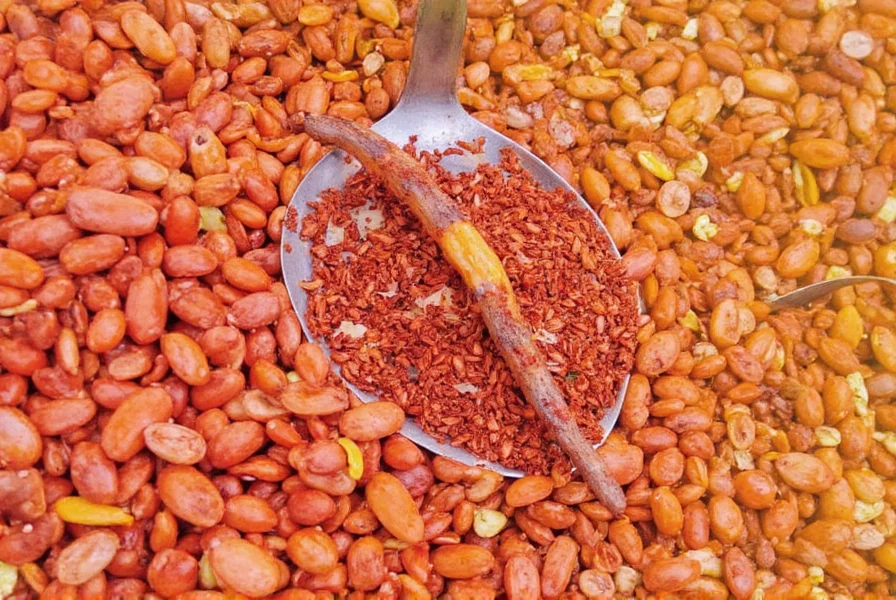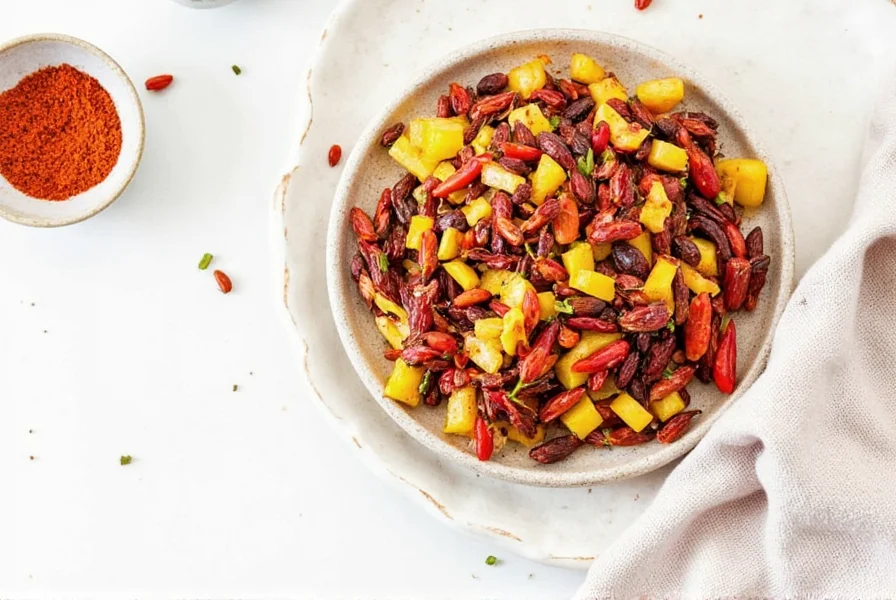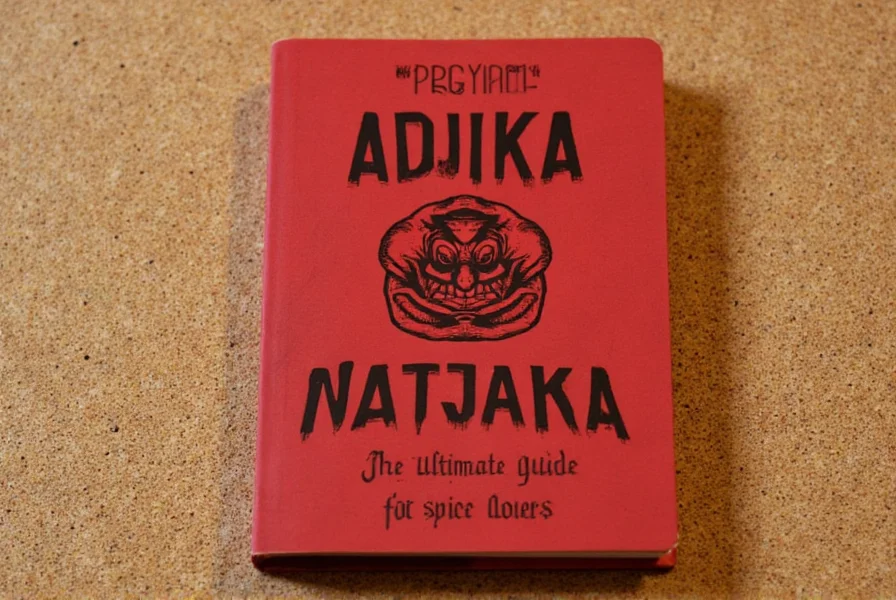Table of Contents
Introduction to Adjika
Adjika is a traditional Georgian spice blend originating from the Caucasus region, made primarily from roasted red bell peppers, garlic, coriander, and chili peppers. It has a smoky, sweet, and slightly spicy flavor profile, and is used as a condiment or seasoning in various dishes. According to traditional Georgian culinary texts, Adjika has been a staple in Georgian cuisine for centuries.
What is Adjika?
Adjika is a traditional Georgian spice blend originating from the Caucasus region, made primarily from roasted red bell peppers, garlic, coriander, and chili peppers. It has a smoky, sweet, and slightly spicy flavor profile, and is used as a condiment or seasoning in various dishes. According to traditional Georgian culinary texts, Adjika has been a staple in Georgian cuisine for centuries. The name 'adjika' comes from the Georgian word for 'spice,' and it's often used as a condiment or seasoning. It's not just for hot dishes—adjika can add depth and complexity to a wide range of foods, from grilled meats to soups and stews.

The Flavor Profile of Adjika
One of the reasons adjika is so popular is its rich and layered flavor. It's a combination of heat, sweetness, and smokiness, making it a perfect balance of flavors. The red bell peppers provide a natural sweetness, while the chili peppers add a nice kick. Garlic and coriander bring a savory, earthy note, and the smokiness usually comes from roasted or sun-dried peppers.
| Spice | Flavor Notes | Heat Level |
|---|---|---|
| Adjika | Smoky, sweet, garlicky, herbal | Moderate to high |
| Cumin | Earthly, nutty, warm | Low to moderate |
| Paprika | Sweet, smoky, mild | Low to moderate |
| Chili Powder | Spicy, smoky, pungent | High |

How to Use Adjika in Your Kitchen
Adjika is incredibly versatile, and there are countless ways to incorporate it into your meals. Here are practical, expert-approved tips:
- As a marinade: Mix adjika with olive oil, lemon juice, and herbs to create a delicious marinade for chicken, fish, or vegetables. For best results, marinate for at least 30 minutes to allow flavors to penetrate.
- As a condiment: Serve it alongside grilled meats, bread, or even eggs for an extra burst of flavor. Traditional Georgian cuisine often pairs adjika with khachapuri (cheese bread) or mtsvadi (skewered meat).
- In soups and stews: Add a spoonful of adjika to tomato-based soups or lentil stews for a deep, smoky taste. It enhances umami without overpowering other ingredients.
- In dips and spreads: Blend it with yogurt or sour cream to make a tangy, spicy dip. This is a popular way to serve adjika in Georgian households as a meze accompaniment.
- On pizza: Sprinkle a bit of adjika over your favorite pizza for a unique, fiery twist. It pairs exceptionally well with mozzarella and fresh tomatoes.
Buying Guide for Adjika
When selecting adjika, consider these objective quality indicators:
- Ingredients: Look for products with simple, natural ingredients like roasted red peppers, garlic, coriander, and chili peppers. Avoid those with artificial additives, preservatives, or fillers.
- Form: Adjika comes in dry spice blend or wet paste form. The paste form often contains oil, vinegar, or lemon juice for preservation. Dry blends are more versatile for cooking, while paste is ready to use as a condiment.
- Origin: Authentic Georgian adjika is made in Georgia, but many brands produce it elsewhere. Check the label for 'Made in Georgia' or 'Traditional Georgian Recipe'.
- Storage: Dry adjika should be stored in an airtight container away from light and heat. Wet paste should be refrigerated after opening.
Frequently Asked Questions
What is adjika spice exactly?
Adjika is a traditional Georgian spice blend originating from the Caucasus region. It is typically made from roasted red bell peppers, garlic, coriander, and chili peppers, though recipes vary by region. According to the Georgian National Food Agency, Adjika has been a staple in Georgian cuisine for centuries. It comes in both dry spice blend and wet paste forms, with the paste version often containing oil, vinegar, or lemon juice for preservation.
How spicy is adjika compared to other hot sauces?
Adjika's heat level ranges from moderate to high, depending on the recipe and pepper varieties used. Traditional Georgian adjika emphasizes a balanced profile where smokiness, garlic, and herbs shine alongside the heat. Compared to harissa (North African chili paste), adjika tends to be less fiery and more herb-forward. It's generally milder than habanero-based sauces but can be spicier than standard paprika or mild chili powders. According to culinary experts, the heat in authentic adjika comes from carefully selected local chili varieties like Georgian "chili pepper" (Capsicum annuum).
Can I make adjika at home, and what ingredients do I need?
Yes, making adjika at home is straightforward. For a basic version, you'll need: 4-5 red bell peppers (roasted), 2-3 hot chili peppers (like cayenne or Aleppo), 4-5 garlic cloves, 1 tablespoon coriander seeds (toasted and ground), 1 teaspoon salt, and 2 tablespoons olive oil. For the wet paste version, add lemon juice or vinegar. Simply blend all ingredients until smooth, then store in a jar with a layer of olive oil on top. Homemade adjika keeps for 2-3 weeks refrigerated or can be frozen for longer storage. Traditional Georgian recipes often include additional ingredients like fresh dill or sumac for regional variations.
How should I store adjika to maintain freshness?
Commercial dry adjika spice should be stored in an airtight container away from light and heat, where it will stay fresh for 6-12 months. Wet adjika paste requires refrigeration—even store-bought versions—and will last 3-4 weeks when properly sealed. For homemade paste, ensure the surface is covered with a thin layer of olive oil to prevent oxidation. You can also freeze adjika paste in ice cube trays for longer storage (up to 6 months), then transfer the frozen cubes to a freezer bag. According to Georgian food safety guidelines, always use clean utensils when handling adjika to prevent contamination.
What are good substitutes for adjika if I can't find it?
If adjika isn't available, you can create a similar flavor profile by mixing 2 parts smoked paprika, 1 part chili powder, 1 part garlic powder, and ½ part ground coriander. For the wet paste version, combine harissa with additional garlic, coriander, and a splash of lemon juice. Other alternatives include zhug (Yemeni hot sauce) with added smoked elements, or a blend of roasted red peppers, garlic, and cayenne. Note that these substitutes won't be identical but will provide a comparable flavor dimension to your dishes. Culinary experts recommend adding a pinch of sumac for a more authentic tangy note when substituting.
Creative Recipes with Adjika
Now that you know how to use adjika, let's dive into some fun and creative recipes where it shines:
1. Adjika-Glazed Chicken Skewers
Ingredients: Chicken breast, adjika, olive oil, lemon juice, salt, and pepper.
Instructions: Marinate chicken skewers in a mixture of adjika, olive oil, and lemon juice for at least 30 minutes. Grill until cooked through and serve with rice or flatbread.
2. Adjika Tomato Soup
Ingredients: Tomatoes, onion, garlic, adjika, vegetable broth, cream, salt, and pepper.
Instructions: Sauté onions and garlic, add chopped tomatoes and broth. Simmer, then blend. Stir in adjika and cream. Season and serve warm.
3. Adjika Hummus
Ingredients: Chickpeas, tahini, lemon juice, garlic, adjika, olive oil, salt, and pepper.
Instructions: Blend all ingredients in a food processor until smooth. Adjust seasoning to taste and serve with pita or veggies.
Conclusion
Adjika spice is more than just a fiery condiment—it's a gateway to a world of rich, complex flavors. Whether you're using it as a marinade, a condiment, or a secret ingredient in your favorite dish, adjika brings something unique to the table. With its roots in Georgia and its growing popularity worldwide, it's no wonder that chefs and home cooks alike are falling in love with this spice.
So next time you're in the kitchen, don't forget to reach for a jar of adjika. You might just discover a new favorite flavor that takes your cooking to the next level. And remember, the key to great cooking is experimenting—and adjika is the perfect spice to spark your creativity.











 浙公网安备
33010002000092号
浙公网安备
33010002000092号 浙B2-20120091-4
浙B2-20120091-4